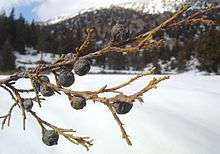Juniperus macropoda
| Juniperus macropoda | |
|---|---|
| | |
| Scientific classification | |
| Kingdom: | Plantae |
| Division: | Pinophyta |
| Class: | Pinopsida |
| Order: | Pinales |
| Family: | Cupressaceae |
| Genus: | Juniperus |
| Species: | J. macropoda |
| Binomial name | |
| Juniperus macropoda Boiss. | |
Juniperus macropoda (Pashto: اوبښته ōbəx̌ta, "[a species] which sucks water"), also called juniperus excelsa polycarpos, or the Pashtun juniper (Pashto: پښتني صنوبر), is a species of juniper native to northern and central Balochistan in western Pakistan, and southeastern Afghanistan.[1]
Description
Juniperus macropoda is a "living fossil".[2] According to some estimations its age ranges from 2000 to 2500 years.[3]

Distribution
Juniperus macropoda is found in Ziarat District and Kalat District, as well as Zarghun Ghar near Quetta and Harboi, in northern and central Balochistan, Pakistan and surrounding parts of southeastern Afghanistan. The largest compact block lies near Ziarat on an approximate range of about 700,000 acres (2,800 km2)[3] and is known as among the largest and oldest juniper forests in the world.
Threats to Juniper
On October 29, 2008 a 6.4 magnitude earthquake hit Ziarat and surrounding areas. After the earthquake distractions the local villagers are now using Juniper trees as fire wood. The juniper forest area is declining day by day there is lack of substantial remedial steps to minimize pressure on juniper cutting has ever been taken to save the centuries-old valuable trees. The local people living in these areas are not provided with the basic necessities of life.

So, they exploit the forest resources for fuel, shelter and food. The major reason of decline of this forest is uses as firewood for daily use, timber for construction, hedges around agricultural fields by the local communities is resulting change in the environment and endangering the rare species of wildlife. Other threats to Juniper include the smuggling of juniper seeds and attack of plant parasite known as mistletoe (Arceuthobium oxycedri) which destroys it in short period.
Bushes / Ground Flora
There are many important species found, bushes and ground flora etc. are associated with this species. Local people use ground flora and these plants as indigenous treatments for a variety of diseases.
See also
References
- ↑ Shah, Syed Ali (July 10, 2013). "In Balochistan, an ancient forest battles for survival". Dawn. Retrieved August 13, 2013.
- ↑ http://agricola.nal.usda.gov/cgi-bin/Pwebrecon.cgi?DB=local&CNT=25&Search_Arg=Juniperus%20macropoda&Search_Code=GKEY&STARTDB=AGRIDB
- 1 2 http://www.pakistanpaedia.com/jungles/juniper_forests.htm